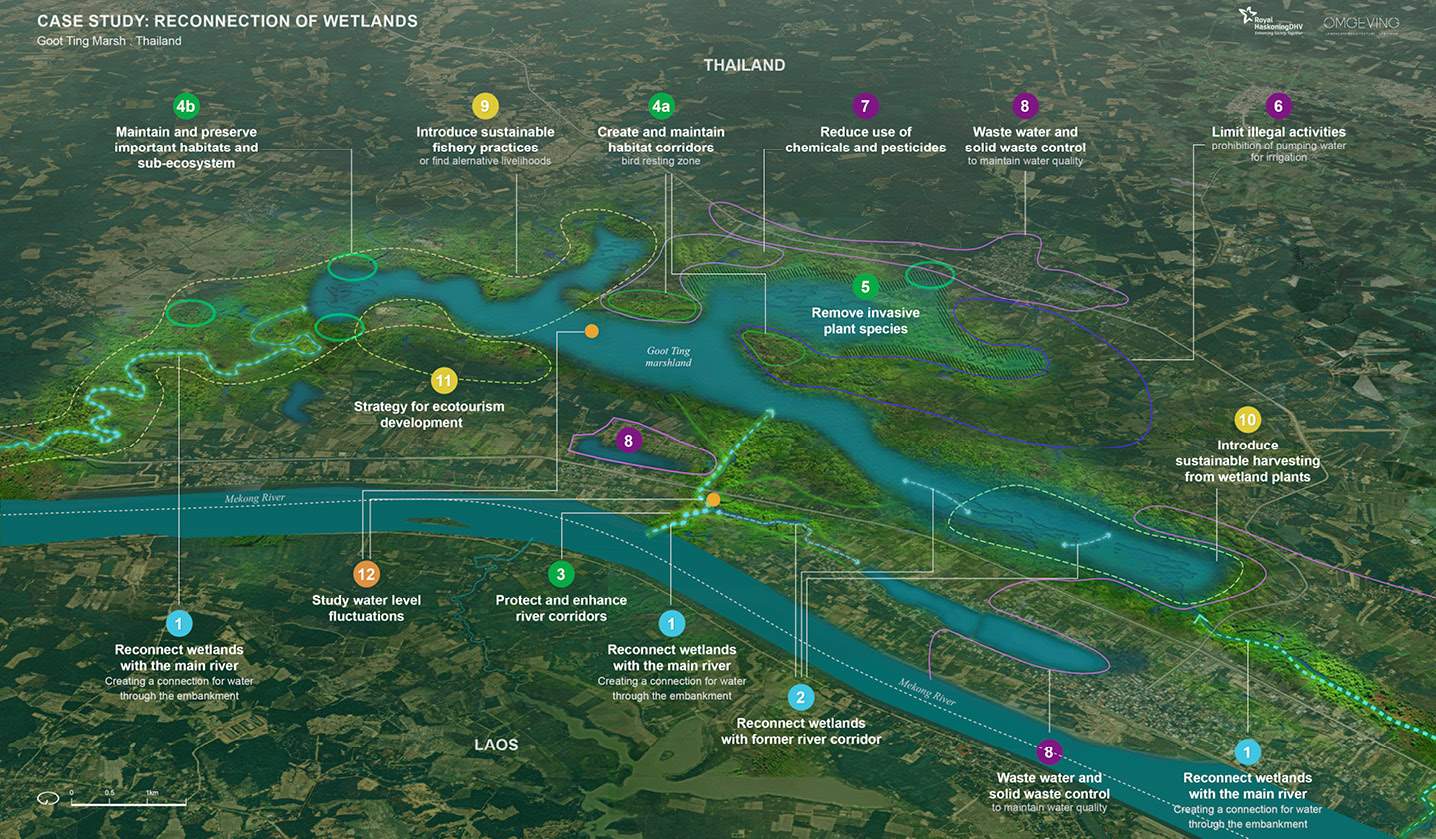Potential NbS measures
This case study area is located at Goot Ting wetland in Thailand, along the Mekong River, five kilometres south of Bueng Kan District, Bueng Kan Province. The site was recognized as a site of international conservation value and registered to the Ramsar site # 1733 in 2010. As described, the main problems are the disconnection of the wetland from the main river, the reduction in size (also see video above), and the reduced ecological quality of the area. To bring back the natural qualities of the wetland, it would be required to restore the connection of the wetland with the main river and restore the wetland's natural characteristics where possible. This might require adjustment of livelihoods to guarantee a stable income with practices that are less destructive to the natural environment.
To restore the connection with the main river, the main structural measure would be to remove an existing embankment locally or install a culvert or sluice gate (1 in the figure above) so that flood waters from the Mekong River can enter the wetland. The same holds for the downstream end of the wetland. A long, narrow channel now leads back to the Mekong River, but the channel may be locally obstructed by vegetation, and there is a weir at the end. Additionally, existing wetland patches can be reconnected (2) to facilitate the flow of water and species and create a significant-sized, fully connected wetland. This mainly concerns two areas west of Goot Ting, which have been disconnected from the main wetland in the past. The newly created connections and corridors should be protected to remain open and keep conveying water (3/4).
Those measures could be further enhanced with biodiversity and conservation measures, such as maintaining or creating important habitats in the area, e.g. a bird resting zone since the area functions as a main important stopover area for migratory birds (4a) and further enhancing/expanding the existing conservation zones for fish (4b). Additionally, invasive plant species, such as water hyacinths, can be removed or suppressed (5). Water hyacinth can diminish dissolved oxygen levels in the water, potentially leading to fish kills, but it also reduces the size of the wetland over time by converting wetlands into land. Water buffalos can aid with removal by eating water hyacinths in shallow areas. Further removal can take place by harvesting and feeding to cattle or drying after harvesting and using it as natural fertiliser. If the stock of native herbivore fish improves in the area, this can also be a natural suppressor for invasive plant species. For the latter, installing specific fishing and no-fishing zones and only deploying sustainable fishing practices is important (9).
To improve and maintain the water quality, it is recommended to reduce the use of chemicals and pesticides in the surrounding area (7) and install policies for water and solid waste disposal in the surrounding villages (8). The high biochemical oxygen demand (BOD), low dissolved oxygen (DO), and high ammonia and coliform bacteria in the area have been associated with the high number of tomato growers and buffalo grazing. There are already some good examples in the area of fishermen encouraging the tomato growers to use organic fertilisers, bio-pesticides and bio-insecticides. Some 15 tomato growers established demonstration organic farms around Goot Ting. Furthermore, if water levels become too low during the dry season, pumping of water for agricultural uses should be limited (6). This might require finding alternative storage areas where rain and/or river water can be stored during the wet season so that water is available during the dry season. Alternatively, agricultural practices could change to practices that require less water during the dry season. The continuous connection with the main river will also aid in improving the water quality within the wetland.
The proposed measures described above may also ask for some adaptation in livelihoods, which will need to shift more towards sustainable fishing practices (9), harvesting of invasive species and/or other sustainable agriculture (5/10), and potentially also the development of eco-tourism (11). WWF has already proposed establishing bird-watching groups at local schools and providing training for bird-watching. Moreover, they have proposed to conduct bird-watching festivals and media tours to the migratory bird habitat sites to enhance eco-tourism. Since the project would still be in a pilot phase, it is recommended to conduct monitoring and evaluation, including at least a study of water levels (12) and monitoring biodiversity and income changes due to changing livelihoods.
